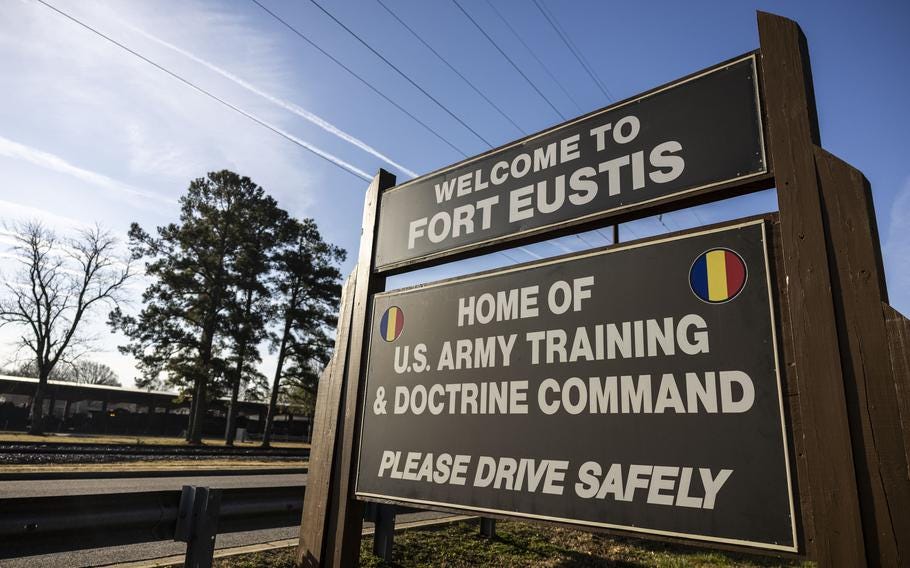Army Launches Most Significant Reorganization in a Generation, Merging Commands and Moving Headquarters to Austin
“We wanted to be with startups. We wanted to be with venture capitalists. We wanted to be with a center of academia.”
May 19, 2025
The U.S. Army is undergoing what military leaders are calling “the most significant transformation the Army has seen in a generation,” as it moves to merge two major commands—Army Futures Command (AFC) and Training and Doctrine Command (TRADOC)—into a single entity headquartered in Austin, Texas.
The newly formed Army Transformation and Training Command is intended to eliminate inefficiencies and prepare the Army for a future defined by emerging threats and rapid technological change. The reorganization was triggered by an April 30 directive from Secretary of Defense Pete Hegseth aimed at divesting “outdated, redundant and inefficient programs.”
“These changes will help the Army transform with urgency to meet the challenges in the priority theater, the Indo-Pacific, and break down institutional barriers and inertia that undermine our transformation efforts,” said a spokesperson for AFC, as quoted in KXAN.
According to Army Chief of Staff Gen. Randy George, the merger will streamline overlapping functions within the two commands.
“Right now we have all these different functions that are trying to do similar things in two commands, and we need to combine those together,” George told Timothy Malcolm in a recent report.
(Image from Stars and Stripes)
Austin Chosen for Innovation and Connectivity
The new command’s headquarters will be located in downtown Austin—already home to Army Futures Command since its establishment in 2018. Army leaders cited the city’s vibrant tech ecosystem and proximity to academic institutions and startups as major factors in the decision.
“The Army headquarters in downtown Austin is here because we wanted to be in a tech hub,” said Gen. Michael C. McCurry, chief of staff at AFC. “We wanted to be with startups. We wanted to be with venture capitalists. We wanted to be with a center of academia.”
Gen. George echoed that sentiment during recent congressional testimony, telling lawmakers: “We like what’s down there as far as the culture, the [Army] Software Factory, the ideas for innovation and change.”
A Future-Oriented Force
The merger reflects a broader shift in Army strategy to meet the demands of future warfare. Leaders emphasize the importance of technological integration and modernization to maintain a tactical edge.
“My number one goal is just to make sure it’s never going to be a fair fight,” said Gen. McCurry. “That our soldiers are armed with things that make it not a fair fight for the guy on the other side.”
Unmanned systems will play a growing role in the Army’s operations, particularly in high-risk or long-duration missions.
“Is it something that’s exceedingly dangerous, like breaching a minefield or penetrating an air defense line? Those things we want to do with machines,” McCurry explained.
He added that protecting soldiers remains central to the Army’s modernization efforts.
“The general thinks first about protecting soldiers, whom he calls the ‘silver bullet’ of the U.S. Armed Forces,” KXAN reported. “Other countries around the world fight a group of things, we fight with a formation of capability. And we try to build that around our soldiers.”
Downsizing and Structural Change
The merger is also part of a broader downsizing effort across the Department of Defense. As part of Secretary Hegseth’s mandate, the Army will reduce the number of four-star generals and admirals by approximately 20%.
“The changes are part of the Army’s efforts to restructure and downsize,” reported Stars and Stripes. “That includes a reduction of about 20% of the military’s four-star generals and admirals.”
Both AFC and TRADOC are currently led by four-star generals, signaling the scale of leadership restructuring ahead.
Impact on Fort Eustis
The consolidation will have significant implications for Fort Eustis, Virginia, which has housed TRADOC headquarters since 2011. The base oversees 32 Army schools and trains over 750,000 soldiers annually. While the Army has confirmed the relocation of the command headquarters, it has not yet disclosed how many personnel will be transferred or what the long-term implications will be for the installation.
“Fort Eustis is set to lose a major command as part of an Army shakeup,” reported WHRO’s Steve Walsh. The lack of specific details has raised concerns among local officials and military families.
According to TRADOC’s official mission statement, the command “trains, educates, develops and builds the Army; establishes standards; drives improvement; and leads change to ensure the Army can deter, fight, and win on any battlefield now and into the future.”
What Comes Next?
While the Army has articulated the goals of the merger, many operational questions remain unanswered. Officials have not yet provided a detailed timeline for the full integration or clarified the structure of the new command.
Nevertheless, the move reflects the Army’s commitment to accelerating innovation and preparing for a future dominated by high-tech warfare in contested global environments.
“This will be the most significant transformation the Army has seen in a generation,” said Lt. Col. Jamie Dobson. “And the important thing to understand is that these changes will make the Army more lethal.”
As the Army turns its eyes toward the Indo-Pacific and beyond, the streets of Austin are set to play a central role in shaping its future force.




